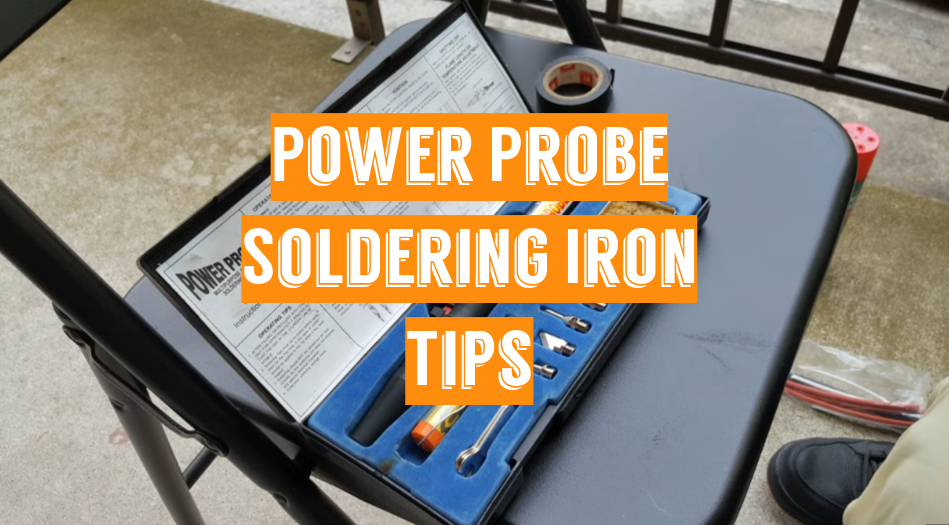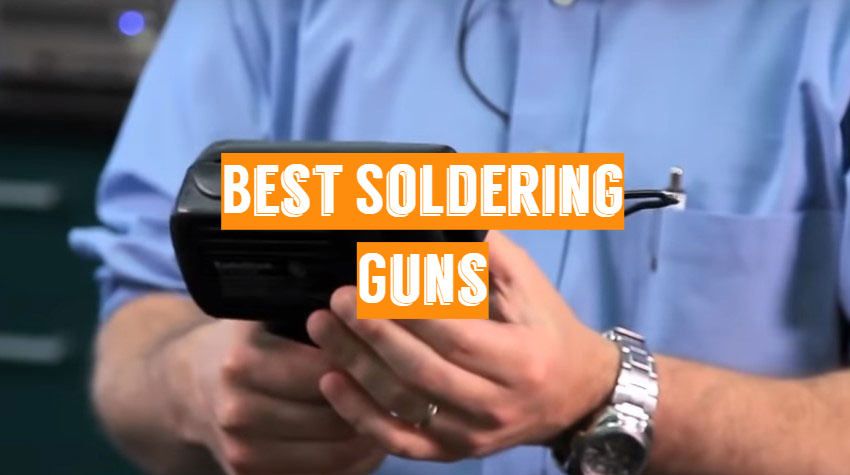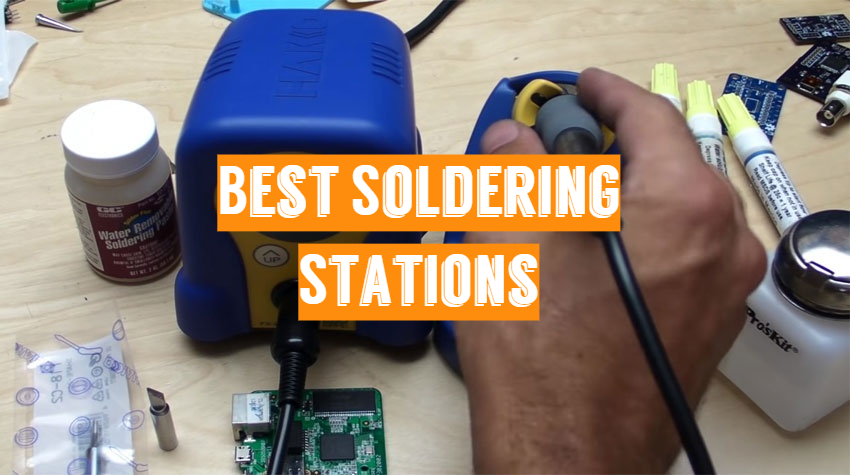
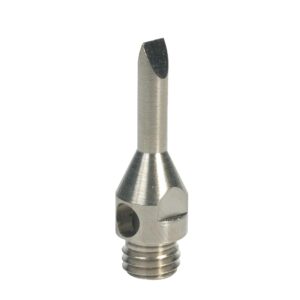
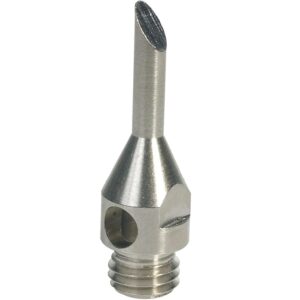
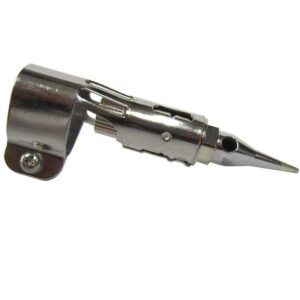
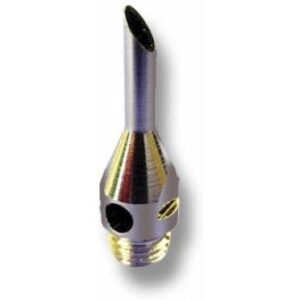
Choose the Best Power Probe Soldering Iron Tip
[modalsurvey id=”880418362″ style=”flat”]Customer’s Choice: the Best Rated Power Probe Soldering Iron Tips
[survey_answers id=”880418362″ style=”plain” data=”score”] users answered this survey. Please help us improve this review!
[survey_answers id=”880418362″ style=”piechart” legend=”true”]
A probe soldering iron tip is used to solder wires and electric components. It heats up quickly, ensuring a fast process of attaching the wire or component to circuit boards. A typical probe soldering iron tip has two tines (or “probes”) that will make contact with both sides of the board during operation. These tips can be purchased individually as they are already set for your desired type of surface mount pad layout in order to ensure a quick setup.
The best probe soldering iron tips might not be the most glamorous tool in your arsenal, but they are an integral part of every electrical or electronic project. If you’re looking for a new tip to replace a worn-out one, this guide got you covered with reviews and useful information on the best probe soldering iron tips. There’s everything from inexpensive to high-end professional-grade models so that there’s something for everyone – regardless of budget restrictions!
Power Probe Standard Solder Tip – the Editor’s choice!
 Turn any piece into a precision tool thanks to the Power Probe Standard Solder Tip. The nickel-plated brass construction is tough enough for heavy-duty use without being too big or bulky to restrict motion while working on small spaces.
Turn any piece into a precision tool thanks to the Power Probe Standard Solder Tip. The nickel-plated brass construction is tough enough for heavy-duty use without being too big or bulky to restrict motion while working on small spaces.
The solder tip screws securely onto a power probe handle for easy heat-up and temperature control that preserves energy. And don’t worry about overheating or burning up your sensitive electronics anymore because this thing has an auto cut-off feature.
Pros
- Secure attachment;
- Tough;
- Designed for PPMT and PPSK tools;
- Nickel-plated brass;
Cons
- Only for small soldering irons;
- Overheating may happen;
Get the job done with this Power Probe Standard Solder Tip and not just be a one-stop with an attached heat sleeve. Made from nickel-plated brass, you can trust that your solder work is permanent and you’ll never have to worry about it leaking again. Just plug in your soldering iron for maximum heat transfer and guaranteed durability at all times.
Power Probe Wedge Tip – the best for butane soldering irons!
 It didn’t take long for our engineers to test the Power Probe Wedge Tip and find it fit perfectly into a butane soldering iron. This tapered tip can be a perfect addition to any handyman’s toolbox.
It didn’t take long for our engineers to test the Power Probe Wedge Tip and find it fit perfectly into a butane soldering iron. This tapered tip can be a perfect addition to any handyman’s toolbox.
The tips are constructed from a high-grade steel alloy that can withstand high temperatures without melting or deforming under pressure. This product comes with two different-sized wedge tips!
Pros
- Good for Power Probe butane and some other soldering irons;
- Decent quality;
- Can withstand high temperature;
Cons
- Pricey;
- Wear off quickly;
Get a perfect fit with the Power Probe Wedge Tip. It’s compatible for use with most butane soldering irons. Get yours today and get back to soldering in just minutes.
Power Probe PPMT08 Chisel Tip – the best for smooth solder joints!
 The Power Probe PPMT08 Chisel Soldering Iron tip will give you a smoother solder joint than ever before. Plated in nickel for durability and made with brass so it holds up against temperature swings, this chisel tip is ready to go on your trusty soldering iron.
The Power Probe PPMT08 Chisel Soldering Iron tip will give you a smoother solder joint than ever before. Plated in nickel for durability and made with brass so it holds up against temperature swings, this chisel tip is ready to go on your trusty soldering iron.
You don’t have to be the perfect soldering expert for this tip. If you’re great at metalwork, control temperature, and are an explosive expert–then this isn’t your starter accessory.
Pros
- Durable;
- Secure and safe to use;
- Smooth solder joints;
- Recommended for PPMT02 and PPSK tools;
Cons
- Sometimes these tips melt;
This tip is great for chiseling and soldering seams. Great for delicate wirework too!
Power Probe PPMT Solder Attachment with Tip – the best for outdoor jobs!
 The brand new Power Probe PPMT Solder Attachment with Tip is engineered for the original PPMT welding tool and addresses one of your biggest pain points – soldering outdoors.
The brand new Power Probe PPMT Solder Attachment with Tip is engineered for the original PPMT welding tool and addresses one of your biggest pain points – soldering outdoors.
Thanks to the nickel-plated steel and porcelain mesh catalyst element, this tip gets hot enough (750 degrees Fahrenheit) to solder tracks in the backcountry or on a farm. Whether you are fixing trails, repairing roofs, or just occupied with an unexpected project in nature – this pro-quality accessory can be very helpful.
Pros
- Can withstand rain and snow;
- Porcelain mesh catalyst;
- Multi-tip application;
- Hot enough to work outside in winter;
Cons
- Only for a specific tool;
- Not easy to replace;
So simple, so affordable, so helpful – this Power Probe solder tip attachment will save your day (and your creation). Make DIY projects easy and hassle-free with these easy-to-use tips.
Power Probe PPPMT08 Replacement Tip – the best as a spare tip!
 The Power Probe PPPMT08 is a great replacement probe for any sort of soldering application, particularly for when the original tips lost their shape.
The Power Probe PPPMT08 is a great replacement probe for any sort of soldering application, particularly for when the original tips lost their shape.
This replacement tip uses high-quality nickel plating to create an extra layer of protection. It also comes equipped with multi-application tips – making this tip all the more versatile!
Pros
- Serves as a great spare tip;
- Budget-friendly;
- Durable;
- Lightweight;
Cons
- Too small for most heavy-duty projects;
The Power Probe PPPMT08 Replacement Tip is essential to any solder kit. These replacement tips are made of nickel-plated steel so they stand up to the heat that solder emits. Comes in a package with 2 different sized metal tips, it’s never hard working on your projects with this handy tip.
The Buyer’s Guide
Types of Probe Soldering Iron Tips
The most popular type of tip is a chisel-plated probe, which comes in either copper or nickel. This style has one flat side and one pointed edge. Chisel tips are typically made with copper alloy metals that resist oxidation when heated to high temperatures, so they can be used repeatedly without corroding or discoloration after prolonged exposure to heat sources like solder fluxes. They also have more surface area than other probe types because their shape increases contact with surfaces during use.
The most common sizes of probe soldering iron tips
In terms of size, there are three major types of probe soldering iron tips: large, medium, and small. Which one is best for you depends on what size the solder joint requires. For example, if you need to go in a tight corner or work with thin wires it may be better to have a smaller tip that can maneuver into tighter spaces easier.
The most common size of soldering iron tips are:
- small tips (0.25mm) can easily solder pin headers but require more precision when soldering larger components like connectors;
- medium-sized tips (0.35mm) are good for large-scale electrical work;
- large tips (0.50mm) are for electronic components such as capacitors – these have tapered ends so you don’t burn your hands while using them;
How to Use a Probe Soldering Iron Tip?
Probe soldering iron tips are not difficult to use, but there is a little technique that’s required. The first thing you’ll need to do is heat your probe tip until it glows red hot and then touches the solder which should flow around the end of the probe. If you’re using lead-free solder, make sure that you allow time for this one-step fluxing process before touching any metal surface with your heated tip as an accidental shortcut could result in something more electrical than mechanical.
The most common mistake people make when working with these irons is trying to apply too much pressure or making sharp movements across surfaces being worked on because they can’t get enough temperature from their tool into certain areas. This will lead to the tip getting too hot and wearing out, as well as being a frustrating experience for whoever is using it.
The major thing you want to do when working with these tools is going slow. Don’t try to work on an area that’s way too big or else you’ll spend most of your time waiting for enough heat from your tool to get through in order to make some progress.
You also need patience because this process can be very challenging at times even though it seems like such a simple task – every surface has cracked solder joint connections which requires more than just heating the metal around them for you to remove them cleanly and completely without damaging nearby surfaces while doing so.
How to Choose Soldering Iron Tips?
Having good quality tips is essential but they also need to fit your needs.
You’ll want a tip that has a larger contact area for making sure the heat transfers properly, and have some sort of small point or edge for reaching into tight spaces. The last thing you would want is a tool with one side flat; this will only work on surfaces where there are large solder joints as opposed to ones that are in corners that may require more precision than what’s possible with such an oddly shaped soldering iron.
To know if the tip size is right, just take it out from its holder and see how well it fits inside the space between two adjacent pins. If they’re spaced far apart then smaller tips are better because you can get closer without risking injury while using them but when they’re close together then larger tips will allow you more room to maneuver.
One of the most important considerations when choosing a soldering iron is what type of tip you will need.
With so many different types on the market, it can be difficult to make a decision and know which one best suits your needs:
- Solder-sucker tips are used for removing excess solder from joints or surfaces that have already been heated up during previous steps in the process;
- Pointed chisel tips allow you to apply pressure while heating them with your torch, giving more control over application than other types do;
- Pointed conical tips give more precision but less heat transfer than some others;
- Wick brushes come with long handles and large loops – they are designed specifically for quickly applying flux before moving onto further stages in fabrication processes;
FAQ
What are different soldering tips used for?
Soldering tips are used to transfer heat onto the hot solder joint you’re trying to connect. They may come alone or at a set of two so that they can be replaced when worn out from use. Soldering irons with interchangeable tips allow for versatility in different soldering jobs. They also make it easy to find replacement tips if needed instead of having an entire new iron unit purchased just because one tip is no longer usable.
Due to their metallic construction, DIYers will often have many varieties available that offer various degrees of conduction (i.e., “hot”, “warm”, etc.), as well as other key features such as insulation material and weight distribution among others.
The type of tip matters and there are 2 common types:
- Conical soldering iron tips have the widest variety, so they’re perfect for general use because in tight spaces where using a traditional pointed one would be difficult. This is because of its shape. It has a wider point at the bottom than on top. These points are better for heating solder because they heat up more evenly, not just in one small area. This happens because these points have more surface area and so they will heat up by contact instead of heating from an electrically charged tip which carries electricity away quickly;
- Chisel-shaped tips are the most common types because they are used for purposes such as soldering copper pipe connections. They are also used to remove solder, meaning they can be turned upside down and put into the joint in order to melt the solder;
Can you sharpen a soldering iron tip?
Yes, with a few basic tools and some patience. You will need to remove the existing solder from the tip in order to sharpen it properly. This process can be time-consuming but is necessary for the optimum performance of your soldering iron. Additionally, you may not want to use this method if you replace tips often or are using a cheap soldering iron that has an easily replaced thermal core inside of the handle that could be damaged during sharpening.
After removing old solder from both sides of the tip (the ferrule side and then on one side of where new solder would go), take a small file and gently scrape off any corrosion from around the edge as well as smoothing out any rough spots until there aren’t many left. This is done by rubbing the file along one side of the tip in a slow, back-and-forth motion to produce a smooth and even edge.
While you are doing this process be sure that you also clean off as much solder flux residue as possible from around both sides of the tip’s surface area where new solder would go because any leftover will interfere with soldering if not cleaned off before use which can lead to poor performance for your soldering iron.
The last step when sharpening a probe type or solid wire type is polishing it up with some steel wool on each side until shiny and clean looking.
Why is my soldering iron tip melting?
The heat coming out of a soldering iron tip is so intense that it can melt the solder you are trying to apply. This may be due to:
- The temperature is too high (usually over 700 degrees Fahrenheit) or insufficiently regulated; for example, setting the dial at “700” and then forgetting about the tool until it went past 800 degrees without adjusting anything. You need a stable and consistent temperature in order to avoid burning your workpiece or melting your tip;
- The bad contact between screwdriver head and tips. This means either not tightening enough during installation, or simply using an incompatible size/type. If this happens while working on something delicate like circuit boards, there will be many overheated, burnt up contact points;
Some people say to clean the electrical contact with some rubbing alcohol, but that does not always work. This is because low voltage might cause problems, like if you have one soldering iron that is plugged into 110 volts and another plugged into 220 volts. They will heat up at different rates even when the temperature is set at the same level.
For problems with a tip that has been worn down or deformed. It is best to replace them with new ones because they are likely not going to be as effective and will need some adjustment for use in different situations.
One way you can ensure your tools are always ready for action is by using a temperature-controlled soldering gun, which automatically heats when it detects resistance from an object being heated. These guns come pre-set at a certain temperature so they don’t need constant adjustment while working on projects – saving time and energy. Make sure not to overdo it though; these devices run hot enough that they could start melting any plastic present if placed too close for too long.
How do you remove oxidation from soldering iron tips?
It is easy to remove oxidation from soldering iron tips. All you need to do is use a wet sponge and some steel wool. You can also purchase this product called Solder-Aid, which will remove the oxidation of your tip in seconds when heated on low heat. It comes with an applicator for convenience and effectiveness.
To be able to effectively clean away all of the oxidized material that may have built up over time, it’s crucial that you use abrasive materials like steel wool or sandpaper while washing them with water as well. The best way to keep them corrosion-free would be by using a solder paste consisting of flux (solder) for electrical conductivity purposes only. This should make sure there are no short circuiting in your electrical circuit and that there are no areas where the solder can’t attach.
How do you clean a soldering iron without flux?
The best way to clean a soldering iron is with cotton or some other type of abrasive material. It’s important not to use any cleaning products as they can severely damage the metal tip and wires used in the device. Always make sure that your solder is liquid, but not too hot, otherwise, you’ll risk damaging those delicate electronics inside your tool.
A common misconception about using flux on an old dirty soldering iron is that it cleans off all the grime from the previous projects. This isn’t true. Flux is only good for metals that are wet. You will need to use it more than once to get the residue off your tools.
Remember: never pour water onto a heated soldering pencil as this could result in electrical shocks, fires or damaged soldering iron.
The best probe soldering iron tips are those that have the flexibility and control to work with all types of solder applications. They should also be easy to clean after use as this will make them last longer in between uses!
How do you clean a soldering iron tip with a sponge?
You should never use a dry sponge or cloth to clean the tip of your soldering iron. The heat will just cause it to melt and deform. Instead, you can use sandpaper, emery paper, or steel wool for this task. It is also important that before handling any type of metal scrubber on the hot surface of your solder tip that you wrap it with an insulating material like copper foil so as not to damage its protective coating.
How do you stop solder bridging?
A common question among beginners is how to avoid solder bridging. The answer to this question can be found in the type of soldering tip you are using. Probe tips, for example, do not bridge because they have a large surface area and so less heat will reach the metal being joined when it touches down on that spot. This also means there’s little risk of melting your workpiece with probe-type tools.
The only downside – these types of tips cannot be used as effectively as direct contact ones if you need precision or detailed control over what you’re doing (such as desoldering). It should also be understood that probe-style irons take longer to get hot than other kinds too.
Video Tutorial: Power Probe Butane Soldering Iron Review
Final thoughts
If you’re looking for a new probe soldering iron tip to replace your worn-out one and want the best of the best, this guide should give you everything that you need. Hopefully, right now you may choose the best probe soldering iron tips for your daily DIY projects.

